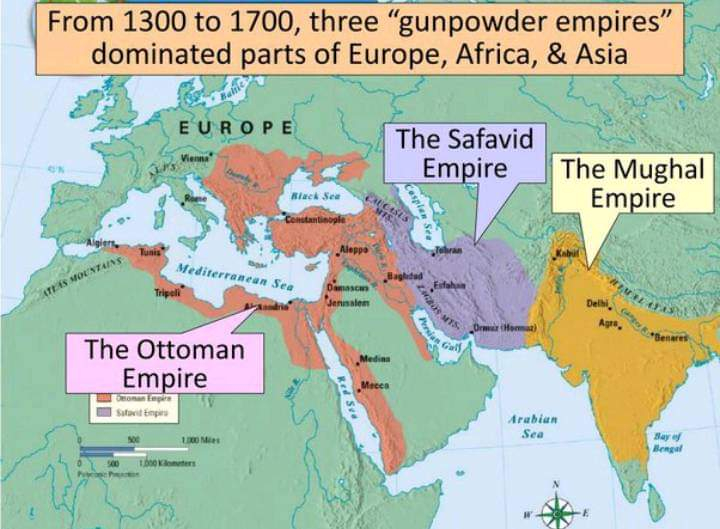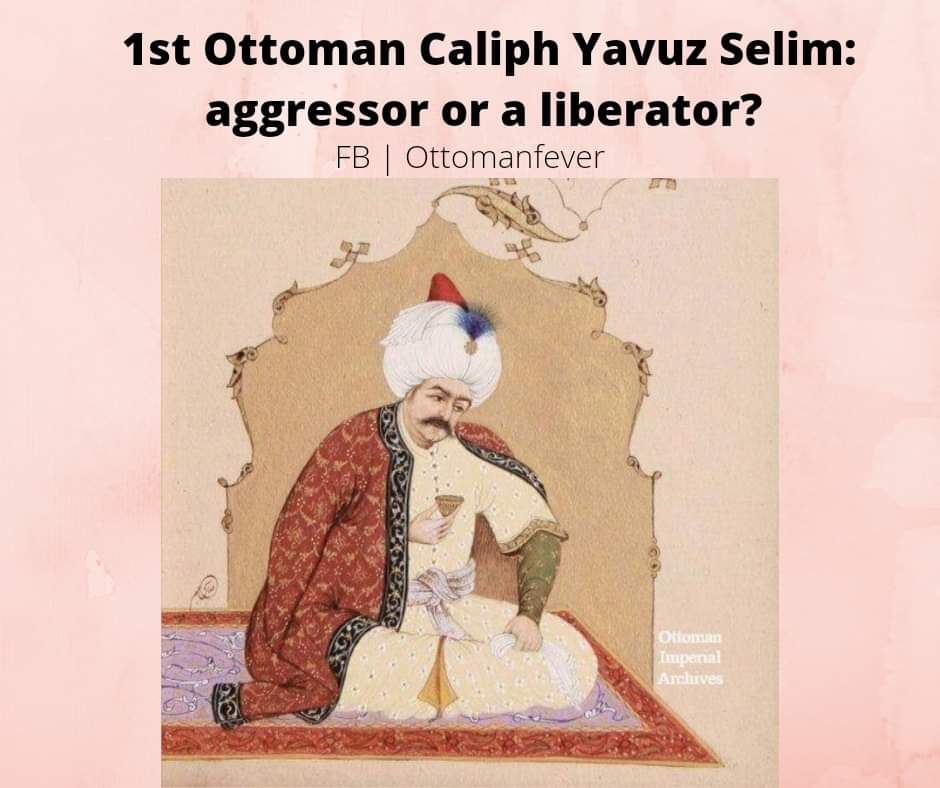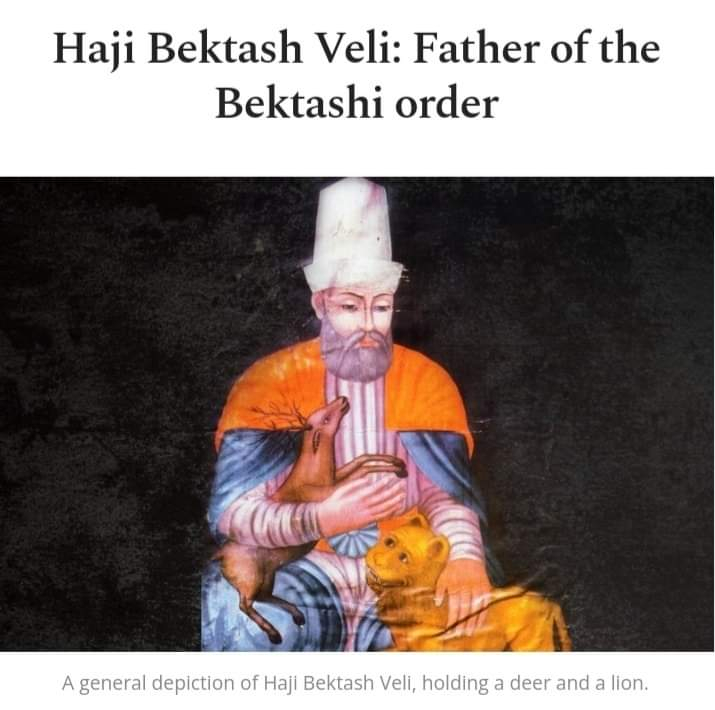𝐀𝐧 𝐢𝐧𝐬𝐢𝐠𝐡𝐭𝐟𝐮𝐥 𝐭𝐡𝐫𝐞𝐚𝐝 𝐨𝐧 𝐭𝐡𝐞 𝐛𝐚𝐜𝐤𝐠𝐫𝐨𝐮𝐧𝐝 𝐨𝐟 𝐭𝐡𝐞 𝐞𝐧𝐭𝐢𝐫𝐞 𝐎𝐭𝐭𝐨𝐦𝐚𝐧-𝐒𝐚𝐟𝐚𝐯𝐢𝐝 𝐰𝐚𝐫. 𝐖𝐚𝐬 𝐒𝐞𝐥𝐢𝐦 𝐭𝐡𝐞 𝐚𝐠𝐠𝐫𝐞𝐬𝐬𝐨𝐫 𝐨𝐫 𝐒𝐡𝐚𝐡 𝐈𝐬𝐦𝐚𝐢𝐥? 𝐋𝐞𝐭'𝐬 𝐟𝐢𝐧𝐝 𝐨𝐮𝐭!
According to historian Daniel W. Brown, Shah Isma'il was "most successful and intolerant Shi'i ruler since the fall of the Fatimids". It appears that he aimed for the complete destruction of Sunni Islam, and he largely achieved that goal in the lands over which he ruled. [5. A new introduction to Islam. Daniel W. Brown, p. 191.]
Ismail's hatred of the Sunnis knew no bounds. He required the first three caliphs to be ritually cursed, abolished Sunni Sufi orders, seizing property, & gave Sunni ulama a choice of conversion, death, or exile. [ Daniel W. Brown (2009). A New Introduction to Islam. pp. 235]
Following his conquests, Shah Ismail Safavid established Twelver Shi‘ism as the state religion throughout his domains, and violently imposed this creed upon his (largely Sunni) subjects in Iran, Iraq, and Azerbaijan by introducing the Shi‘i call to prayer and instituting the practice of sabb whereby the first three Caliphs, the Prophet’s wife ‘Ā’isha, and a number of the Prophet’s Companions were ritually cursed and vilified.[ Jean Calmard, “Tabarru’.” Encylopedia of Islam, Second Edition, ed. P. Bearmanet al., Brill: Brill Online, 2013; Arjomand, The Shadow of God and the Hidden Imam, p. 109;]
Moreover, Ismā‘īl’s conquests were accompanied by mass violence against Sunni communities, the devastation of their property, and the destruction of shrines, including those of the important Sunni figures of Abu Ḥanīfa (d. 767) and ‘Abd al-Qādir Gīlānī (d. 1166) in Baghdad.[Scherberger, “The Confrontation between Sunni and Shi’i Empires,” p. 54; Shaw, History of the Ottoman Empire, p. 78]
Various massacres also took place: 10,000 were executed near Hamadan in 1503; 4000 members of the Kaziruni Sufi order were murdered in Fars, while all the tombs of rival Sufi orders were desecrated; ten thousand refuges and dissenters who took up refuge in Asta were put to the sword; the entire cities of Yazd, Tabas and Abarquh was slaughtered, tens of thousands of people in these three cities alone according to Safavid chronicles; in Khurasan, the tomb of Abd al-Rahman Jami (d. 1492) was destroyed and the entire population of Qarshi—about 15,000 people—massacred.[Mitchell, The Practice of Politics in Safavid Iran, pp. 24–67]
These quotes by prominent historians clearly show that Shah Ismail was a war mongering
lunatic who subjected the Sunni masses all over Persia, Azerbaijan, and Iraq to a horrible genocide. He had raised the banner of hatred and oppression against innocent Sunnis. This is why it was incumbent upon Yavuz Selim Han to put an end to this reign of terror once and for all. Selim rose against his own father, Bayezid II, not for power or fame but for a noble cause of liberating Sunni masses who had been facing death and destruction at the hands of Safavid troops. Also, Selim had vowed to take revenge from Ismail for his policy of cursing the Noble Rashidun Caliphs (Sayyidina Abu Bakr, Sayyidina Umar, Sayyidina Usman) by shattering his foolish delusions of invincibility. The following excerpt taken from a letter of Ottoman Caliph Selim to Shah Ismail 1 reflect his resolve:
"It has been seen repeatedly that you have subjected upright community of Muhammad ﷺ (Prayers and salutations upon its founder!) to your devious will, that you have undermined the firm foundation of the Faith, that you have unfurled the banner of oppression in the cause of aggression
If Allah Almighty wills, the lightning of our conquering sword shall uproot the untamed bramble grown to great heights in the path of the refulgent Divine Law and shall cast them down upon the dust of abjectness to be trampled under the hooves of our legions, for “They abase the mightiest of its inhabitants and these will do the same” (Qur’an 27: 34); the thunder of our avenging mace shall dash out the muddled brains of the enemies of the Faith as rations for the lionhearted ghazis. “The wrongdoers will realize what a reversal they shall have.” (Qur’an 26: 227)
Let them remove the cotton of negligence from the ears of their intelligence and, with their shrouds on their shoulders, prepare themselves for “That which you are threatened with is sure to come.” Qur’an 6: 134) The triumphant troops “As firm as a mighty edifice” (Qur’an 61: 4) crying out like fate evoked “When their hour is come, not for one moment shall they hold it back, nor can they go before it” (Qur’an 7: 34) "
Source for letter: Feridun Bey’s Munsha’at, a sixteenth-century collection of documents between the Ottoman sultan Selim I, and the founder of the Safavid Dynasty, Shah Ismail al-Safawi
#Ottoman #yavuz #Selim #Osmanli #Safavid #Persia #Iraq #azerbaijan𝐀𝐧 𝐢𝐧𝐬𝐢𝐠𝐡𝐭𝐟𝐮𝐥 𝐭𝐡𝐫𝐞𝐚𝐝 𝐨𝐧 𝐭𝐡𝐞 𝐛𝐚𝐜𝐤𝐠𝐫𝐨𝐮𝐧𝐝 𝐨𝐟 𝐭𝐡𝐞 𝐞𝐧𝐭𝐢𝐫𝐞 𝐎𝐭𝐭𝐨𝐦𝐚𝐧-𝐒𝐚𝐟𝐚𝐯𝐢𝐝 𝐰𝐚𝐫. 𝐖𝐚𝐬 𝐒𝐞𝐥𝐢𝐦 𝐭𝐡𝐞 𝐚𝐠𝐠𝐫𝐞𝐬𝐬𝐨𝐫 𝐨𝐫 𝐒𝐡𝐚𝐡 𝐈𝐬𝐦𝐚𝐢𝐥? 𝐋𝐞𝐭'𝐬 𝐟𝐢𝐧𝐝 𝐨𝐮𝐭!
According to historian Daniel W. Brown, Shah Isma'il was "most successful and intolerant Shi'i ruler since the fall of the Fatimids". It appears that he aimed for the complete destruction of Sunni Islam, and he largely achieved that goal in the lands over which he ruled. [5. A new introduction to Islam. Daniel W. Brown, p. 191.]
Ismail's hatred of the Sunnis knew no bounds. He required the first three caliphs to be ritually cursed, abolished Sunni Sufi orders, seizing property, & gave Sunni ulama a choice of conversion, death, or exile. [ Daniel W. Brown (2009). A New Introduction to Islam. pp. 235]
Following his conquests, Shah Ismail Safavid established Twelver Shi‘ism as the state religion throughout his domains, and violently imposed this creed upon his (largely Sunni) subjects in Iran, Iraq, and Azerbaijan by introducing the Shi‘i call to prayer and instituting the practice of sabb whereby the first three Caliphs, the Prophet’s wife ‘Ā’isha, and a number of the Prophet’s Companions were ritually cursed and vilified.[ Jean Calmard, “Tabarru’.” Encylopedia of Islam, Second Edition, ed. P. Bearmanet al., Brill: Brill Online, 2013; Arjomand, The Shadow of God and the Hidden Imam, p. 109;]
Moreover, Ismā‘īl’s conquests were accompanied by mass violence against Sunni communities, the devastation of their property, and the destruction of shrines, including those of the important Sunni figures of Abu Ḥanīfa (d. 767) and ‘Abd al-Qādir Gīlānī (d. 1166) in Baghdad.[Scherberger, “The Confrontation between Sunni and Shi’i Empires,” p. 54; Shaw, History of the Ottoman Empire, p. 78]
Various massacres also took place: 10,000 were executed near Hamadan in 1503; 4000 members of the Kaziruni Sufi order were murdered in Fars, while all the tombs of rival Sufi orders were desecrated; ten thousand refuges and dissenters who took up refuge in Asta were put to the sword; the entire cities of Yazd, Tabas and Abarquh was slaughtered, tens of thousands of people in these three cities alone according to Safavid chronicles; in Khurasan, the tomb of Abd al-Rahman Jami (d. 1492) was destroyed and the entire population of Qarshi—about 15,000 people—massacred.[Mitchell, The Practice of Politics in Safavid Iran, pp. 24–67]
These quotes by prominent historians clearly show that Shah Ismail was a war mongering
lunatic who subjected the Sunni masses all over Persia, Azerbaijan, and Iraq to a horrible genocide. He had raised the banner of hatred and oppression against innocent Sunnis. This is why it was incumbent upon Yavuz Selim Han to put an end to this reign of terror once and for all. Selim rose against his own father, Bayezid II, not for power or fame but for a noble cause of liberating Sunni masses who had been facing death and destruction at the hands of Safavid troops. Also, Selim had vowed to take revenge from Ismail for his policy of cursing the Noble Rashidun Caliphs (Sayyidina Abu Bakr, Sayyidina Umar, Sayyidina Usman) by shattering his foolish delusions of invincibility. The following excerpt taken from a letter of Ottoman Caliph Selim to Shah Ismail 1 reflect his resolve:
"It has been seen repeatedly that you have subjected upright community of Muhammad ﷺ (Prayers and salutations upon its founder!) to your devious will, that you have undermined the firm foundation of the Faith, that you have unfurled the banner of oppression in the cause of aggression
If Allah Almighty wills, the lightning of our conquering sword shall uproot the untamed bramble grown to great heights in the path of the refulgent Divine Law and shall cast them down upon the dust of abjectness to be trampled under the hooves of our legions, for “They abase the mightiest of its inhabitants and these will do the same” (Qur’an 27: 34); the thunder of our avenging mace shall dash out the muddled brains of the enemies of the Faith as rations for the lionhearted ghazis. “The wrongdoers will realize what a reversal they shall have.” (Qur’an 26: 227)
Let them remove the cotton of negligence from the ears of their intelligence and, with their shrouds on their shoulders, prepare themselves for “That which you are threatened with is sure to come.” Qur’an 6: 134) The triumphant troops “As firm as a mighty edifice” (Qur’an 61: 4) crying out like fate evoked “When their hour is come, not for one moment shall they hold it back, nor can they go before it” (Qur’an 7: 34) "
Source for letter: Feridun Bey’s Munsha’at, a sixteenth-century collection of documents between the Ottoman sultan Selim I, and the founder of the Safavid Dynasty, Shah Ismail al-Safawi
#Ottoman #yavuz #Selim #Osmanli
#Safavid #Persia #Iraq #azerbaijan




